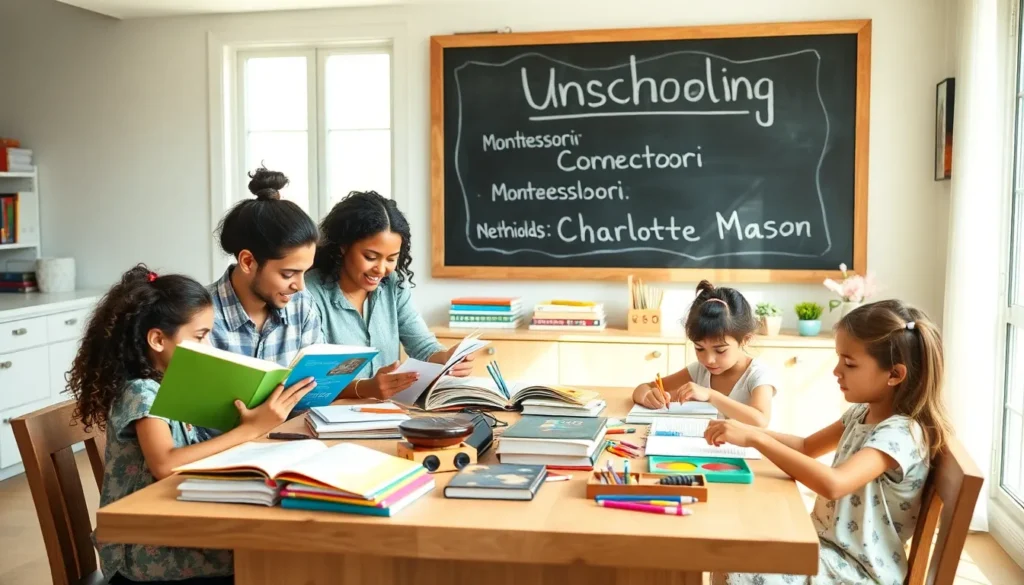Table of Contents
ToggleHomeschooling has become a popular choice for many families, but what exactly does it entail? Think of it as a buffet of educational styles, where each method offers its own unique flavor. You might think homeschooling is all about textbooks and rigid schedules, but that couldn’t be further from the truth. In this text, we’ll be diving into the various types of homeschooling methods that can suit different needs and lifestyles. Whether your child is a hands-on learner, a free spirit, or thrives within a structured environment, there’s a homeschooling method that fits. Grab your notebook, because we’re about to explore the diverse world of homeschooling with clarity and a sprinkle of humor.
Understanding Homeschooling

Homeschooling is more than just an educational choice: it’s a lifestyle. Families who choose this route take charge of their children’s education, designing a curriculum that fits their individual learning styles and needs. In essence, homeschooling allows for personalized learning in a comfortable environment. It’s a flexible alternative to traditional school, offering freedom to learn at one’s own pace. Besides, it can foster a closer family bond as children engage in learning together with their parents or caregivers.
Traditional Homeschooling
Traditional homeschooling can resemble a more conventional school experience but takes place at home. Parents usually adopt structured lesson plans, often using textbooks, worksheets, and standardized tests to guide their teaching. This method allows for a familiar curriculum framework, which makes it easier for parents to measure academic progress. Still, it also allows families to adjust pacing based on their child’s comfort level. Traditional homeschooling is particularly appealing to parents who appreciate a classic educational structure.
Unschooling
Unschooling flips traditional education on its head. Instead of adhering to set curriculums, it embraces a more organic approach to learning. Kids follow their interests, sparking curiosity as they explore topics that genuinely engage them. For instance, if your child loves dinosaurs, they could jump into paleontology without ever opening a textbook. This method encourages creativity and fosters a love for lifelong learning. Critics may argue that structure is lacking, but advocates argue it creates self-motivated learners who are excited about education.
Charlotte Mason Method
The Charlotte Mason method emphasizes the importance of literature and hands-on learning experiences. Charlotte Mason, an educator from the early 20th century, advocated for immersive, rich learning that goes beyond the confines of textbooks. Through engaging stories, art, nature study, and music, this approach aims to nourish a child’s development holistically. Families using this method might spend time in gardens, read classic literature, and observe wildlife, matching learning with life experiences. It’s a way to cultivate not just knowledge but also imagination.
Montessori Homeschooling
Montessori homeschooling draws inspiration from the Montessori education philosophy developed by Dr. Maria Montessori. It fosters independence and self-directed learning. In this method, children choose their activities from a range of options and work at their own pace. The environment is carefully prepared to encourage exploration and discovery. For example, children might engage in crafting, practical life skills, or sensory activities. The key here is to respect the child’s natural learning rhythm while guiding their growth. This hands-on approach can yield impressive cognitive and social skills.
Online and Virtual Homeschooling
In our digital age, online and virtual homeschooling has gained tremendous popularity. Families can subscribe to online curricula providing lessons, assessments, and resources, all accessible from a computer. Virtual classes take it a step further, connecting students with live instructors in various subjects. This method offers flexibility while still providing external guidance. Parents often appreciate the ease of having curriculum delivered straight to their home, allowing them to focus on supporting their child rather than creating lessons from scratch.
Hybrid Homeschooling Models
Hybrid homeschooling combines elements of traditional schooling with homeschooling. In this model, students attend classes a few days a week at a brick-and-mortar school and complete their remaining studies at home. This setup can provide socialization opportunities while also allowing families to customize their learning experience. It’s a happy middle ground for parents who see value in both structured education and personalized learning. Families might find that hybrid models help ease the transition into full-time homeschooling or supplement traditional education.
Choosing The Right Homeschooling Method
With so many options available, choosing the right homeschooling method can feel overwhelming. Families should consider their child’s learning style, interests, and the amount of structure they seek. It’s essential to reflect on family values and lifestyles, as some methods require more hands-on involvement than others. Researching each method and connecting with other homeschoolers can provide invaluable insight that makes the decision process smoother. Eventually, the best method is one that fits seamlessly into a family’s life and fosters a love for learning.







